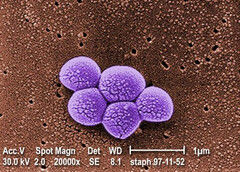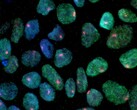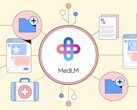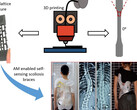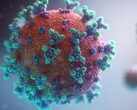Integrated Biosciences has discovered a new class of antibiotics that are effective at killing antibiotic-resistant MRSA and other germs. The company utilized AI deep learning trained on key parts of current antibiotics that kill to achieve this. This discovery helps counter the growing problem of drug-resistant bacteria.
Methicillin-resistant staphylococcus aureus is one example of a bacteria that has become ever more drug-resistant. Current antibiotics are losing their effectiveness as deaths increase yearly. Thousands die from MRSA infections, and the death rate after infection, even among non-symptomatic carriers, is much higher than normal.
Traditional methods of antibiotic drug discovery can easily exceed a $1 billion and take decades. Integrated Biosciences had their AI search for viable antibiotics through a set of 12 million candidates using just software rather than lab work. The AI was trained to know what aspects of a molecule leads to high antibiotic activity and importantly toxicity. This bypassed the tedious work needed to isolate, then test candidates one-by-one in the lab.
Although discovering a new class of antibiotics quickly is astonishing given the recent paucity in this field, new drugs must still be carefully tested in animal and human studies, so these are still years from reaching the market. Sports atheletes and children are vunerable to infections due to the nature of their play, but even sharing contaminated razors can spread MRSA. In the meantime, you can kill antibiotic-resistant MRSA and other germs on surfaces and toys at home using an EPA registered disinfectant (such as this at Amazon).
Integrated Biosciences Announces Nature Publication Identifying New Class of Antibiotics Discovered Via Company’s AI-Powered Platform
Publication validates the use of explainable deep learning in drug discovery and identifies a new class of antibiotics, one of the few in 60 years
Antimicrobial resistance is a public health crisis that is projected to kill 10 million people worldwide per year by 2050, and MRSA alone kills over 10,000 people each year in the U.S. Researchers at Integrated Biosciences have discovered the first-ever class of antibiotics identified using a new and explainable artificial intelligence. These antibiotics specifically and potently kill MRSA and other bacterial pathogens. (Photo: Business Wire)
December 20, 2023 11:00 AM Eastern Standard Time
SAN CARLOS, Calif.--(BUSINESS WIRE)--Integrated Biosciences, a biotechnology company pioneering the use of synthetic biology and machine learning to develop next-generation therapeutics for age-related diseases, today announced the publication in the journal Nature of a peer-reviewed manuscript detailing the application of its platform in the discovery of a new class of small molecule antibiotics capable of addressing antibiotic resistance. This discovery represents one of the first new classes of antibiotics in the past 60 years and is the first discovered leveraging an AI-powered platform built around explainable deep learning. The paper, entitled “Discovery of a structural class of antibiotics with explainable deep learning,” was co-authored by a team of 21 researchers, led by Felix Wong, Ph.D., co-founder of Integrated Biosciences, and James J. Collins, Ph.D., Termeer Professor of Medical Engineering and Science at MIT and founding chair of the Integrated Biosciences Scientific Advisory Board.
Additional collaborators included researchers at the Massachusetts Institute of Technology (MIT), the Broad Institute of MIT and Harvard, the Wyss Institute for Biologically Inspired Engineering, and the Leibniz Institute of Polymer Research in Dresden, Germany. In their study, the researchers virtually screened more than 12 million candidate compounds to identify this new class of antibiotics.
“This discovery of a new class of antibiotics is a breakthrough result showing that artificial intelligence and explainable deep learning are uniquely capable of catalyzing drug discovery,” said Dr. Wong. “Our work makes publicly available several high-powered models to accurately predict both antibiotic activity and toxicity. Importantly, this is one of the first demonstrations that deep learning models can explain what they are predicting, with immediate and far-reaching implications to how drug discovery is done and how efficiently we can find new drugs using AI.”
Satotaka Omori, Ph.D., founding member and Head of Aging Biology at Integrated Biosciences, and a contributing author on the publication, said, “An important implication of this study is that deep learning models in drug discovery can, and in many cases should, be made explainable. While AI continues to make an impact, it is also limited by the many black box models that are commonly used and obfuscate the underlying decision-making process. By opening up these black boxes, we aim to create more generalizable insights that may be more useful in accelerating the use and development of next-generation approaches to drug discovery.”
In this groundbreaking approach, the team of researchers trained deep learning models on experimentally generated data to predict the antibiotic activity and toxicity of any compound. Drawing inspiration from AI used in other contexts, including DeepMind’s AlphaGo gaming technology, the authors designed new models to explain which parts of a molecule were important for antibiotic activity. The result was a new class of antibiotics with potent activity against multidrug-resistant pathogens. In one series of experiments, the researchers tested a candidate antibiotic in mouse models of MRSA infection and found that it was efficacious both topically and systemically, indicating that the compound could be suitable for further development as a treatment for severe and sepsis-related bacterial infections.
“This is an important validation of how important the integration of AI and explainable deep learning will be to overcoming some of the most vexing challenges in medicine, in this case antibiotic resistance,” said Dr. Collins. “Building on these validating studies and similar approaches, the Integrated Biosciences team is poised to further accelerate their integration of synthetic biology and a deep understanding of cellular stress to address a significant unmet need for new treatments targeting age-related diseases.”
“In any given class of drugs, there are often persistent issues that have limited clinical development. A key innovation in this study was that we could look to explainable deep learning to help us address specific issues, such as resistance and toxicity, and find solutions quickly,” said Dr. Wong.
Alicia Li, a research associate at Integrated Biosciences and a contributing author on the publication, added, “It’s really exciting to see how we’ve been able to demonstrate a new way to predict how useful a compound will be as an antibiotic, the likelihood that the compound will progress in Phase I trials, and whether or not the compound is one of potentially many other members in a novel class of drugs.”
Integrated Biosciences has built a body of research that, in addition to this new Nature publication, includes a Nature Aging paper published in May demonstrating how AI can be used to discover novel senolytics, anti-aging compounds that selectively eliminate senescent “zombie” cells. These compounds have shown promise in their ability to treat age-related diseases, such as fibrosis, inflammation, and cancer. A Cell Systems paper published in July demonstrated a synthetic biology-based platform allowing human control over aging-associated stress responses, enabling accelerated drug screens for targeting aging.
The publication, “Discovery of a structural class of antibiotics with explainable deep learning,” can be accessed on the Nature website at: www.nature.com/articles/s41586-023-06887-8.
About Integrated Biosciences
Integrated Biosciences is an emerging biotechnology company pioneering novel approaches that combine synthetic biology and AI-driven small-molecule drug discovery to produce next-generation therapeutics targeting age-related diseases. The company was founded in 2022 by MIT-, Harvard- and Princeton-trained scientists Felix Wong, Ph.D., and Max Wilson, Ph.D., in 2022. Its scientific advisors include James J. Collins, Ph.D., Termeer Professor of Medical Engineering and Science at MIT, Sir David W. C. MacMillan Ph.D., winner of the 2021 Nobel Prize in Chemistry, and James S. McDonnell Distinguished University Professor of Chemistry at Princeton. Integrated Biosciences investors include Root Ventures, Mission BioCapital, Conscience VC, Reinforced Ventures, and Polymath Capital. For more information, visit: www.integratedbiosciences.com.
Contacts
Media:
Anthony Petrucci
Bioscribe
512-581-5442
anthony@bioscribe.com


